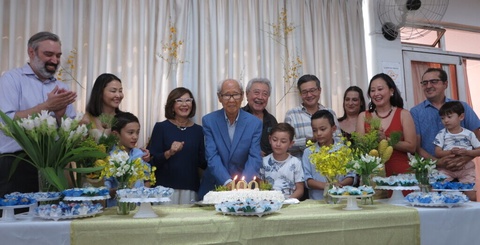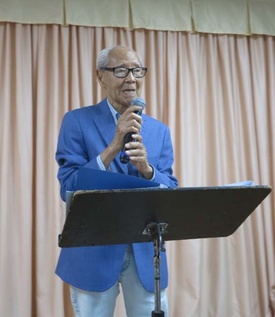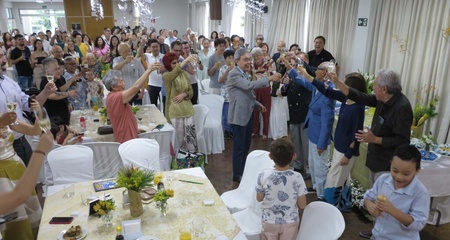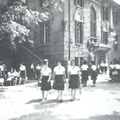To reach 100 years of age in good health
Yoshiaki Umezaki (born in Nara Prefecture), who lives in the southern part of Sao Paulo, turned 100 on March 21 and recently published his fourth collection of tanka. In addition, a grand 100th birthday celebration party was held on the 25th at the Shizuoka Prefectural Hall, attended by 120 relatives and friends, and was hosted by his family.
He can converse without hearing aids, composes tanka and other writings every day, climbs the stairs to the stage by himself to greet people, and regularly visits our association. There are dozens of people in Colonia who live to be 100 years old, but few reach their 100th birthday in such good health. When we asked him about the secret to his health, he only modestly replied, "I haven't done anything special." However, during a celebration party, his eldest daughter Regina quietly revealed the secret.
According to the Nippon.com website , as of September 1, 2022, there are a whopping 90,526 people over 100 years old in Japan. In Brazil, according to the Artee Cuidar website, the number is over 30,000. Brazil has a population about twice that of Japan, and one-third of its people are over 100 years old. That makes them rare here. And a healthy 100-year-old is a rare thing.
According to the National Institute of Geography and Statistics (IBGE), the average life expectancy of Brazilians is 76 years. Some research suggests that in the past decade, life expectancy has increased by two years, but healthy life expectancy has been lost by three years. It is difficult to "age healthily." I would like to take inspiration from Umezaki's way of life.
A living dictionary of immigration history
Umezaki was born in Nara Prefecture on March 21, 1923, and moved to Brazil with his family at the age of nine in 1932, in the midst of the Constitutional Revolution. He has lived there for 91 years since then. Umezaki contributed the following article, " Memories of the Constitutional Revolution in São Paulo ," to the Nikkei Shimbun on July 29, 2015.
July 9th is the anniversary of the Brazilian Constitutional Revolution. During the midst of that revolution, on July 26th (1932), about 800 of us immigrants arrived at Rio de Janeiro Port on the Osaka merchant ship La Plata Maru.
Rio was known as one of the world's third most beautiful ports at that time, and the immigrants planned to land in the city and enjoy the scenery. They sent a radio message from the ship to the immigration office to apply for landing, but they didn't receive an OK reply. It seems that everything is paralyzed by the revolution.
When the thick fog that had been hanging over us cleared at dawn, the famous Pão de Azucar rock formations, known from photographs, rose up before our eyes, and two or three flying boats were floating near the ship. After a while, one of them flew up, splashing water, and circled the sky above the city for several tens of minutes. When it returned, another plane took off. It was apparently on guard against the revolutionary army infiltrating the city.
The ship repeatedly applied for permission to land throughout the day, but to no avail, so at night they headed south toward Santos.
Fortunately, they were allowed to disembark at the port of Santos. Under normal circumstances, they would have been sent by train from there to an immigrant detention center in the city of São Paulo, but the detention center was being used as lodgings for the revolutionary army. Umeyoshi Akiho came to greet them, bowing before them all and saying, "I'm truly sorry, but you will be staying in this town (Santos) tonight and leaving for the interior by train early tomorrow."
The number of people was close to 800. They were assigned to hotels and inns, but there were not enough beds in any of the hotels, so they had to sleep in the hallways. The immigrants were dissatisfied, wondering how far they would fall.
I was a 10-year-old boy, so I ignored the adults' complaints and looked out the hotel window to the outdoors, where I saw sandbag-lined trenches stretching out on both sides, and dozens of soldiers staring ahead with their guns aimed.
A man who seemed to be a superior shouted something, and the soldiers all jumped over the sandbags and ran forward. It seemed to be a mass training of the revolutionary army. When I was admiring how brave they were, the bearded hotel owner pulled me inside. It seemed that he was very wary of the revolution.
This turmoil must have been an experience for the 800 people who immigrated together, but I haven't seen much written about it. I sometimes include this revolution in the novels I write, so some of you may have read them.
It's a vivid testimony. The "Constitutional Revolution" was a revolution in which the people of São Paulo state rebelled against the federal government in Rio. Getulio Vargas, who lost the presidential election in 1930, seized power in a successful military coup, citing dissatisfaction with political corruption at the time, and suspended the constitution. Dissatisfied with this, the people of São Paulo state started a revolution in 1932, demanding "protect the constitution." This was the Constitutional Revolution.
There are very few Issei who have experienced the largest civil war in Brazilian history firsthand, making them valuable as "living witnesses to the history of immigration."
*This article is reprinted from the Brazil Nippo (April 4, 2023).
© 2023 Masayuki Fukasawa








